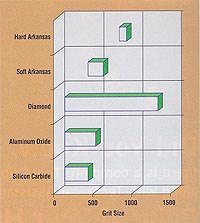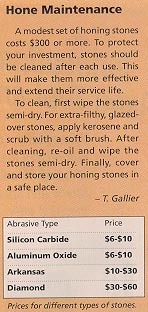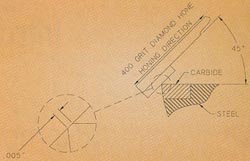



There are many variables to consider when trying to optimize a metalworking process. In the simplest terms, you have to squeeze as much productivity as possible out of every aspect of the process. That includes the reconditioning of cutting tools.
When it comes to tools and optimizing a process, one question must be answered: Are the tools being fully utilized? If hand honing isn’t part of your tool-reconditioning program, the answer is no.
Tool life, which is intimately tied to part quality and productivity, can be increased through the proper selection and application of hones.
Stone Selection
The first step in tool honing is stone selection. Matching the stone to the job is of paramount importance. A compatible match is as essential as selecting the correct wheel for a tool-grinding operation. In fact, the forethought required for both honing and tool grinding is similar. Consideration must be given to tool geometry and material and to the degree of abrasiveness needed for the job.
Hones are available in a multitude of shapes, sizes and abrasive types. The vast assortment can seem overwhelming to the beginner. But once the selection process is understood, the best choice soon becomes obvious.
Cutting tools also come in many shapes and sizes. A tool’s basic geometry usually consists of either planar or curved surfaces. Even special shapes are a combination of these two geometries. Stone shapes for planar surfaces include square, rectangle, triangle, diamond or any combination of these shapes. Curved surfaces require stones that are round, half-round or concave.
The geometry of the tool’s cutting edge will determine the best stone for the job. A good stone for the 1/4"-radius form tool shown in Figure 1a, for example, would be round, have a 1/2" diameter and be made of a medium-grit aluminum oxide. (Other recommended shapes and sizes are depicted in Figures 1b, 1c and 1d.) Generally, if the surface area of the cutting edge is large, select a large stone.
Choosing the appropriate abrasive is the next task. The most common hone materials are Al2O3, silicon carbide, diamond and Arkansas (hard quartzite).
Most cutting tools are manufactured from either HSS or carbide. The old school of thought reserved diamond hones for carbide tools, but the real determining factor in abrasive selection is the required rate of material removal. Expect a rapid rate of material removal when using a diamond hone on HSS cutting tools.
The next step is choosing the grit size. Grits range from coarse to extra fine (Table 1). The determining factor in grit-size selection is the required surface finish. Finish improves as the grit number increases.

Table 1: The determining factor in selecting grit size is the required surface finish, which improves as the grit number increases.
The finer the surface finish required for the cutting edge, the longer it will take to hone the tool. Every tool doesn’t require a superpolished cutting edge, so choose a stone with the appropriate grit.
Stone Application
After selecting the best stone for the job, the next step is applying it to the tool’s cutting edge. Successful honing largely depends on two things: holding the hone at the proper angle and moving it in the correct direction.
The angle of the stone must match the angle of the surface being honed. So, if you are honing a 7° primary angle, the hone must be held at 7° as well. The hone should always move in the direction of the cutting edge. That is, it should move from the relief surface to the cutting surface.
It is essential to keep the stone flat on the surface to be honed. Consistent pressure between the stone and the surface being honed is equally important. The original angle will begin to change if this pressure fluctuates. In the worst-case scenario, the cutting edge will be dulled.
A fluid lubricant must be used during the honing process. Even an oil-filled stone requires an external lubricant. Oil is usually the best choice. It removes swarf from the work area and enhances the sharpening process. Without a lubricant, the honing stone will load. And, as with a loaded grinding wheel, it will degrade the operation.
Poor honing practices sabotage rather than enhance tool performance, driving up costs. Improper honing wastes the time and materials used to recondition the tool, as well as a portion of the tool’s service life. Additional time can be lost after the tool is returned to service, as the machine operator tries to make the “new” dull tool work.
Opting not to hone cutting tools can cost a machine shop even more. To illustrate this, consider deburring, a common type of honing.
Hones are used to deburr cutting tools after they have been ground. A burr is a small sliver of hardened tool steel or carbide. The tool’s cutting edge will be damaged if this sliver becomes dislodged and gets trapped between the edge and the workpiece. A cutting tool that’s not deburred after reconditioning can have its service life shortened by as much as 50 percent. With the average carbide tool costing $200, it’s easy to see how much money proper honing can save.
 Another common honing application is called “quick sharpening.” It can be more cost-effective than a reconditioning operation that includes grinding. If a tool is just slightly worn (the wear land is less than 0.003"), it only needs a quick sharpening with a hone.
Another common honing application is called “quick sharpening.” It can be more cost-effective than a reconditioning operation that includes grinding. If a tool is just slightly worn (the wear land is less than 0.003"), it only needs a quick sharpening with a hone.
Often, a tool with minimal wear is set up and ground. This unnecessary practice wastes time and grinding wheels and decreases the tool’s service life. Inspect tools before they are ground. Separate the quick-sharpening jobs from the true grinding jobs.
Production machining processes can also benefit from quick sharpening. If workpiece quality, such as surface finish or dimensional stability, begins to deteriorate, a quick sharpening of the cutting tool while it’s on the machine often can bring a process back into control. Similarly, if a visual inspection of the cutting edge reveals a small amount of built-up edge, quick sharpening will alleviate the problem.
A third type of honing is superfinishing, which involves applying more than one stone to the cutting edge. It takes the honing process a step beyond deburring.
A coarse-grit stone is used for roughing, followed by a fine-grit stone. The best guide for selecting stones is experience, which can be gained by testing different combinations on obsolete or scrapped tools.
Superfinishing reduces the microscopic irregularities found on all cutting edges. During the cutting action, the chip slides against the tool, and the tool slides against the workpiece. The friction caused by the sliding action is the tool-wear mechanism. Friction is a function of surface finish, so improving the finish will decrease frictional resistance. That, in turn, will increase tool life and improve workpiece quality.
Honing can improve operations in other ways, too. For example, a 400-grit diamond hone can be used to add a special land to a carbide tool to strengthen its cutting edge (Figure 2). This would be done if the carbide grade were too hard for a specific job, if the workpiece surface were too rough (scale on the raw stock) or if the application called for an interrupted cut. The width of the land should not exceed 0.005" and must be at a 45° angle to the cutting edge.

Figure 2: A hone can be used to add a land to a tool’s cutting edge, which strengthens it.
Start Light
Learning to hone correctly takes patience and practice. Begin with less aggressive stones, apply light pressure and inspect your work frequently with an optical comparator. After gaining experience, move on to more aggressive stones, increase the work pressure and visually inspect the tool. (A correctly prepared cutting edge will not reflect light.)
The learning process can also be shortened by talking to hone manufacturers. They have a wealth of knowledge that they will be glad to share.
When executed correctly, the honing operation will enhance overall cutting performance. Additionally, tooling costs will decrease and the number of parts produced per tool can rise by as much as 20 percent.
About the Author
Tory Gallier is a senior tool engineer at Delta Faucet Co., Chickasha, Okla.
Related Glossary Terms
- abrasive
abrasive
Substance used for grinding, honing, lapping, superfinishing and polishing. Examples include garnet, emery, corundum, silicon carbide, cubic boron nitride and diamond in various grit sizes.
- aluminum oxide
aluminum oxide
Aluminum oxide, also known as corundum, is used in grinding wheels. The chemical formula is Al2O3. Aluminum oxide is the base for ceramics, which are used in cutting tools for high-speed machining with light chip removal. Aluminum oxide is widely used as coating material applied to carbide substrates by chemical vapor deposition. Coated carbide inserts with Al2O3 layers withstand high cutting speeds, as well as abrasive and crater wear.
- built-up edge ( BUE)
built-up edge ( BUE)
1. Permanently damaging a metal by heating to cause either incipient melting or intergranular oxidation. 2. In grinding, getting the workpiece hot enough to cause discoloration or to change the microstructure by tempering or hardening.
- burr
burr
Stringy portions of material formed on workpiece edges during machining. Often sharp. Can be removed with hand files, abrasive wheels or belts, wire wheels, abrasive-fiber brushes, waterjet equipment or other methods.
- flat ( screw flat)
flat ( screw flat)
Flat surface machined into the shank of a cutting tool for enhanced holding of the tool.
- grinding
grinding
Machining operation in which material is removed from the workpiece by a powered abrasive wheel, stone, belt, paste, sheet, compound, slurry, etc. Takes various forms: surface grinding (creates flat and/or squared surfaces); cylindrical grinding (for external cylindrical and tapered shapes, fillets, undercuts, etc.); centerless grinding; chamfering; thread and form grinding; tool and cutter grinding; offhand grinding; lapping and polishing (grinding with extremely fine grits to create ultrasmooth surfaces); honing; and disc grinding.
- grinding wheel
grinding wheel
Wheel formed from abrasive material mixed in a suitable matrix. Takes a variety of shapes but falls into two basic categories: one that cuts on its periphery, as in reciprocating grinding, and one that cuts on its side or face, as in tool and cutter grinding.
- grit size
grit size
Specified size of the abrasive particles in grinding wheels and other abrasive tools. Determines metal-removal capability and quality of finish.
- high-speed steels ( HSS)
high-speed steels ( HSS)
Available in two major types: tungsten high-speed steels (designated by letter T having tungsten as the principal alloying element) and molybdenum high-speed steels (designated by letter M having molybdenum as the principal alloying element). The type T high-speed steels containing cobalt have higher wear resistance and greater red (hot) hardness, withstanding cutting temperature up to 1,100º F (590º C). The type T steels are used to fabricate metalcutting tools (milling cutters, drills, reamers and taps), woodworking tools, various types of punches and dies, ball and roller bearings. The type M steels are used for cutting tools and various types of dies.
- interrupted cut
interrupted cut
Cutting tool repeatedly enters and exits the work. Subjects tool to shock loading, making tool toughness, impact strength and flexibility vital. Closely associated with milling operations. See shock loading.
- land
land
Part of the tool body that remains after the flutes are cut.
- metalworking
metalworking
Any manufacturing process in which metal is processed or machined such that the workpiece is given a new shape. Broadly defined, the term includes processes such as design and layout, heat-treating, material handling and inspection.
- relief
relief
Space provided behind the cutting edges to prevent rubbing. Sometimes called primary relief. Secondary relief provides additional space behind primary relief. Relief on end teeth is axial relief; relief on side teeth is peripheral relief.
- swarf
swarf
Metal fines and grinding wheel particles generated during grinding.
